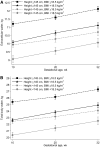Maternal nutritional status in early pregnancy is associated with body water and plasma volume changes in a pregnancy cohort in rural Bangladesh
- PMID: 22535759
- PMCID: PMC3349982
- DOI: 10.3945/jn.111.155978
Maternal nutritional status in early pregnancy is associated with body water and plasma volume changes in a pregnancy cohort in rural Bangladesh
Abstract
Plasma volume expansion has been associated with fetal growth. Our objective was to examine the associations between maternal nutritional status in early pregnancy and extracellular water (ECW), total body water (TBW), and percentage plasma volume change across pregnancy. In a subsample of 377 pregnant women participating in a cluster-randomized trial of micronutrient supplementation, hemoglobin, hematocrit, and multi-frequency bioelectrical impedance were measured at ~10, 20, and 32 wk of gestation. In early pregnancy, women were short (mean ± SD, 148.9 ± 5.3 cm) and thin (19.5 ± 2.5 kg/m(2)). In mixed-effects multiple regression models, a 1-unit higher BMI at ~10 wk was associated with higher ECW and TBW (0.27 and 0.66 kg per kg/m(2), respectively; P < 0.01) at ~10, ~20, and ~32 wk. Height was also positively associated with ECW and TBW at each time point. Early pregnancy BMI was negatively associated with gains in ECW and TBW (-0.06 and -0.14 kg per kg/m(2), respectively; P < 0.01) from 10 to 20 wk, but not with 20- to 32-wk gains after accounting for weight gain. BMI was positively associated with percentage changes in plasma volume from 20 to 32 wk (0.57% per kg/m(2); P < 0.05). Height was not associated with changes in body water or plasma volume. Women with low BMI and height in early pregnancy have lower ECW and TBW in early, mid, and late pregnancy and lower late pregnancy plasma volume expansion, potentially increasing risk of fetal growth restriction.
Conflict of interest statement
Author disclosures: A. D. Gernand, P. Christian, K. J. Schulze, S. Shaikh, A. B. Labrique, A. A. Shamim, and K. P. West Jr, no conflicts of interest.
Figures

References
-
- Hytten F. Blood volume changes in normal pregnancy. Clin Haematol. 1985;14:601–12 - PubMed
-
- Ghezzi F, Franchi M, Balestreri D, Lischetti B, Mele MC, Alberico S, Bolis P. Bioelectrical impedance analysis during pregnancy and neonatal birth weight. Eur J Obstet Gynecol Reprod Biol. 2001;98:171–6 - PubMed
-
- Rosso P, Donoso E, Braun S, Espinoza R, Salas SP. Hemodynamic changes in underweight pregnant women. Obstet Gynecol. 1992;79:908–12 - PubMed
-
- Hytten FE, Paintin DB. Increase in plasma volume during normal pregnancy. J Obstet Gynaecol Br Emp. 1963;70:402–7 - PubMed
-
- Pirani BB, Campbell DM, MacGillivray I. Plasma volume in normal first pregnancy. J Obstet Gynaecol Br Commonw. 1973;80:884–7 - PubMed

